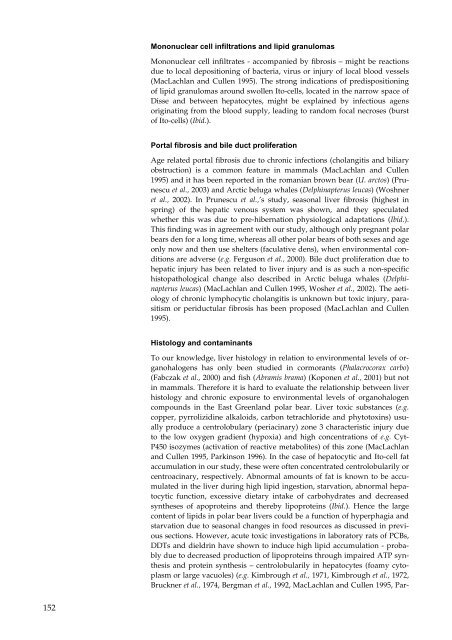Organohalogen concentrations and a gross and histologic ...
Organohalogen concentrations and a gross and histologic ...
Organohalogen concentrations and a gross and histologic ...
Create successful ePaper yourself
Turn your PDF publications into a flip-book with our unique Google optimized e-Paper software.
152<br />
Mononuclear cell infiltrations <strong>and</strong> lipid granulomas<br />
Mononuclear cell infiltrates - accompanied by fibrosis – might be reactions<br />
due to local depositioning of bacteria, virus or injury of local blood vessels<br />
(MacLachlan <strong>and</strong> Cullen 1995). The strong indications of predispositioning<br />
of lipid granulomas around swollen Ito-cells, located in the narrow space of<br />
Disse <strong>and</strong> between hepatocytes, might be explained by infectious agens<br />
originating from the blood supply, leading to r<strong>and</strong>om focal necroses (burst<br />
of Ito-cells) (Ibid.).<br />
Portal fibrosis <strong>and</strong> bile duct proliferation<br />
Age related portal fibrosis due to chronic infections (cholangitis <strong>and</strong> biliary<br />
obstruction) is a common feature in mammals (MacLachlan <strong>and</strong> Cullen<br />
1995) <strong>and</strong> it has been reported in the romanian brown bear (U. arctos) (Prunescu<br />
et al., 2003) <strong>and</strong> Arctic beluga whales (Delphinapterus leucas) (Woshner<br />
et al., 2002). In Prunescu et al.,’s study, seasonal liver fibrosis (highest in<br />
spring) of the hepatic venous system was shown, <strong>and</strong> they speculated<br />
whether this was due to pre-hibernation physiological adaptations (Ibid.).<br />
This finding was in agreement with our study, although only pregnant polar<br />
bears den for a long time, whereas all other polar bears of both sexes <strong>and</strong> age<br />
only now <strong>and</strong> then use shelters (faculative dens), when environmental conditions<br />
are adverse (e.g. Ferguson et al., 2000). Bile duct proliferation due to<br />
hepatic injury has been related to liver injury <strong>and</strong> is as such a non-specific<br />
histopathological change also described in Arctic beluga whales (Delphinapterus<br />
leucas) (MacLachlan <strong>and</strong> Cullen 1995, Wosher et al., 2002). The aetiology<br />
of chronic lymphocytic cholangitis is unknown but toxic injury, parasitism<br />
or periductular fibrosis has been proposed (MacLachlan <strong>and</strong> Cullen<br />
1995).<br />
Histology <strong>and</strong> contaminants<br />
To our knowledge, liver histology in relation to environmental levels of organohalogens<br />
has only been studied in cormorants (Phalacrocorax carbo)<br />
(Fabczak et al., 2000) <strong>and</strong> fish (Abramis brama) (Koponen et al., 2001) but not<br />
in mammals. Therefore it is hard to evaluate the relationship between liver<br />
histology <strong>and</strong> chronic exposure to environmental levels of organohalogen<br />
compounds in the East Greenl<strong>and</strong> polar bear. Liver toxic substances (e.g.<br />
copper, pyrrolizidine alkaloids, carbon tetrachloride <strong>and</strong> phytotoxins) usually<br />
produce a centrolobulary (periacinary) zone 3 characteristic injury due<br />
to the low oxygen gradient (hypoxia) <strong>and</strong> high <strong>concentrations</strong> of e.g. Cyt-<br />
P450 isozymes (activation of reactive metabolites) of this zone (MacLachlan<br />
<strong>and</strong> Cullen 1995, Parkinson 1996). In the case of hepatocytic <strong>and</strong> Ito-cell fat<br />
accumulation in our study, these were often concentrated centrolobularily or<br />
centroacinary, respectively. Abnormal amounts of fat is known to be accumulated<br />
in the liver during high lipid ingestion, starvation, abnormal hepatocytic<br />
function, excessive dietary intake of carbohydrates <strong>and</strong> decreased<br />
syntheses of apoproteins <strong>and</strong> thereby lipoproteins (Ibid.). Hence the large<br />
content of lipids in polar bear livers could be a function of hyperphagia <strong>and</strong><br />
starvation due to seasonal changes in food resources as discussed in previous<br />
sections. However, acute toxic investigations in laboratory rats of PCBs,<br />
DDTs <strong>and</strong> dieldrin have shown to induce high lipid accumulation - probably<br />
due to decreased production of lipoproteins through impaired ATP synthesis<br />
<strong>and</strong> protein synthesis – centrolobularily in hepatocytes (foamy cytoplasm<br />
or large vacuoles) (e.g. Kimbrough et al., 1971, Kimbrough et al., 1972,<br />
Bruckner et al., 1974, Bergman et al., 1992, MacLachlan <strong>and</strong> Cullen 1995, Par-

















